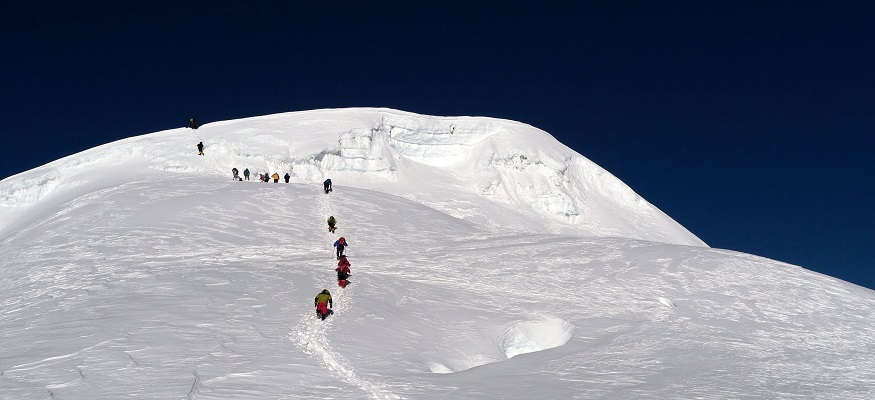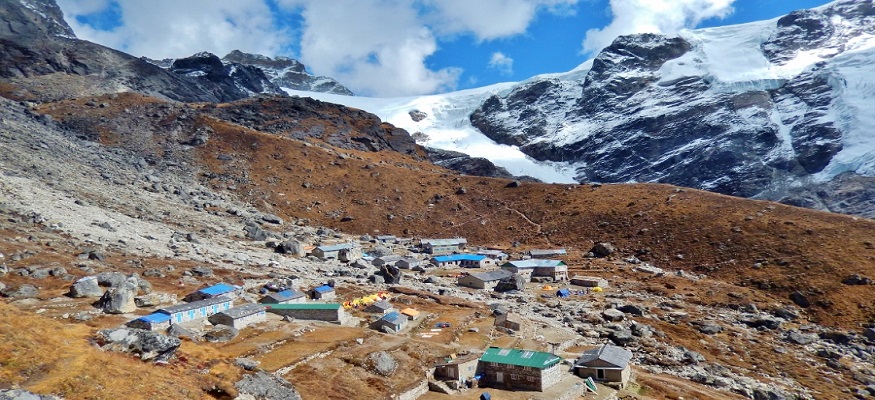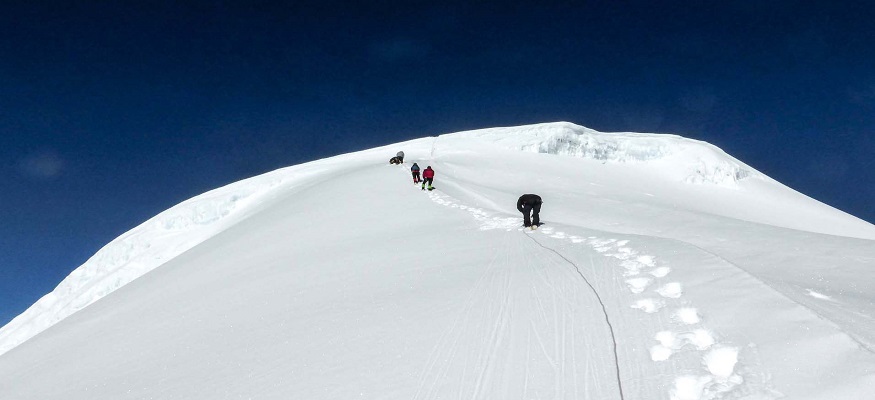One of Nepal's most famous and accessible peaks, Mount Mera, or Mera Peak, is located in the country's north and rises from the Kathmandu Valley. Mount Mera is taller than five other seven peaks at 6,476 meters/21,247 feet.
Here is a little-known fact, though. Its top may be reached relatively quickly, and standing there doesn't need much technical expertise.
About Mount Mera or Mera Peak
Mera Peak is a mountain peak in Sagarmatha National Park, Sankhuwasabha, in the Barun sub-part and Mahalangur sector of the Himalayas. It is a hiking peak since it is 6,476 meters (21,247 feet) in height.
 Image Source: Himalayan Wild Treks
Image Source: Himalayan Wild Treks
Caption: Mount Mera or Mera Peak
British expeditions studied the region thoroughly in the early 1950s, both before and after the climb of Everest. Sir Edmund Hillary, Tenzing Norgay Sherpa, George Lowe, and Eric Shipton were among those on those teams.
The traditional approach from the north entails high-altitude glacier trekking. The peak's west and south sides provide more demanding technical routes. Mera Peak offers 360-degree panoramic views of five of the world's tallest peaks above 8000 meters: Mount Everest, Kangchenjunga, Lhotse, Makalu, and Cho Oyu, as well as numerous other summits in the Khumbu Region.
It is a technically uncomplicated ascent for experienced climbers, with the primary challenge being sufficient acclimatization to the high altitude. Mera Peak is a popular location for these reasons, with several adventure tour companies offering guided expeditions to the peak for individuals with little or no climbing expertise.
Why Should You Climb Mount Mera?
There are several reasons why you should try climbing Mount Mera. They are:
- Mount Mera offers a chance for hikers and climbers who want to stand on a Himalayan peak but need more time for rigorous preparation.
- Mera Peak is one of Nepal's top vistas. As previously demonstrated, it provides one of the most excellent views money can buy.

Image Source: Furtenbach Adventures
Caption: Porters climbing Mount Mera
- The hike to Khare, the final hotel stop, is one of the most excellent hiking experiences we've experienced. It's as though each day has a different theme. On the first day, we begin with a cultural experience and go through a rhododendron route, spectacular coniferous woods, glacier walk, high altitude lakes, alpine meadows, mountain peak, climbing training, high pass to Lukla, and ultimately flight from Lukla.
- This is also conceivable with family members. Non-climbers can stay at Khare, and you can rejoin them in two days.
The Best Time to Climb Mount Mera
Preparation, planning, climbing ability, health, and weather conditions contribute to a successful ascent of any mountain. The weather is arguably the most critical aspect in Mera.
The optimum seasons to try Mount Mera are Spring (March-May) and Autumn (September-November). Also, allow at least three days in case of weather-related delays.
How hard is it to climb Mount Mera?
Mount Mera was once classified as Alpine Grade F (easy), but owing to glacial changes in the mountains and a challenging climb in the last stretch, it is now classified as Alpine Grade PD (slightly tricky). As a result, climbing Mount Mera is an ideal choice for anybody searching for high-altitude activities with little or no mountaineering expertise.
Regardless of the grading, you must use caution while intending to climb a 6,476-meter-high peak. Here are some things to think about:
Trek to Khare
Typically, we will see snow or ice once we reach Khare. If the route is dry up to this point, it is simple, requiring only trekking poles and approach shoes.
 Image Source: On Top
Image Source: On Top
Caption: Khare Village
However, damp circumstances may make steep slopes slippery and tricky. Prepare with decent shoes, physical stamina on inclines, and the standard trekking gear.
Altitude Sickness
Aside from the weather, the most typical reason why efforts to climb Mount Mera fail is altitude sickness. Mera is a relatively high peak despite its specific path involving little or no difficult climbing.
Supplemental oxygen will always be accessible in our climbs, even if it is not necessary for most individuals. Consider utilizing bottled oxygen if you don't feel right. Only be concerned if others are using it. Everyone responds differently to altitude.
Be aware of the following:
- Acute Mountain Sickness(AMS)
- High Altitude Cerebral Edema(HACE)
- High Altitude Pulmonary Edema(HAPE)
Technical Skills
The ascent to the Mera summit is simple. Most of the climb is spent walking on a glacier with crampons and ice axes on a steep incline. If the weather permits, the last phase of the climb comprises an ascent of a snow dome at a 50-degree inclination utilizing an ascender/jumar on a fixed rope.
Physical Training and Fitness
Stamina is also an essential aspect of a successful climb. If planned adequately with full acclimatization days, a physically fit individual may efficiently complete this journey with minimal risk. Consider hitting the gym, hiking, and climbing. Training in a hypobaric setting, if accessible, will also be quite beneficial.
How long does it take to scale Mera Peak?
There are several routes for scaling Mount Mera. When counting days from Kathmandu, the shortest tour takes 12 days, while the longest takes 19 days. Nonetheless, the 12-day schedule will give many individuals Acute Mountain Sickness(AMS).
This suggests that summit hopes are slim on that route unless another trip has adequately acclimatized everyone. We'll tell you what we believe is best for Mera, but first, let us provide some background.
 Image Source: Himalaya View Treks
Image Source: Himalaya View Treks
Caption: Mera Peak
Given that Altitude Related Conditions are the primary reason summit efforts to Mount Mera fail, a cautious strategy is required. Consider the following essential factors:
Climb only 500 m daily
This climbing plan is only for altitudes more than 2,500 meters. While this is not a universal rule, following this climb plan as closely as possible will keep most people in check. Please remember that the difference refers to the difference in sleep altitudes rather than the highest peak achieved throughout the day.
Camp an Extra night at 1,000 m
Climbers usually stay an extra night following a 1,000-meter ascent on most regular routes. For example, on the Everest Base Camp Trek, two nights are spent in Namche at 3,440 meters and two nights in Dingboche, situated at 4,340 m. This approach is practical again when going more than 2,500 meters. Acclimatization walks to a high-altitude location are also required during rest days.
Climb high, sleep low
The route that travels through high altitudes and then descends to spend the night at a lower altitude is the best for acclimatization. This allows your body to begin adjusting to the challenges of high altitude, but by the time AMS develops, you are already in a safe zone.















